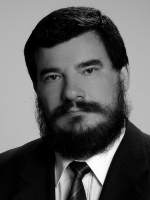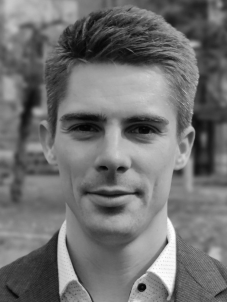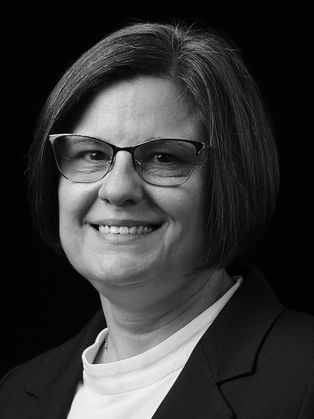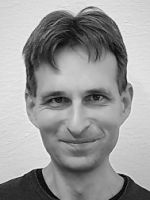
A 2023/24-es tanév előadásai / Seminars in the academic year 2023/24
23 May 2024
 Sergey Korotov (Mälardalen University, Sweden)
Sergey Korotov (Mälardalen University, Sweden)
Red refinements and Zhang tetrahedra
In this talk we shall present and discuss various properties of the so-called red refinements of simplices, mainly in the context of tetrahedral meshes. A special emphasis will be given to the appearance of various undesired effects like degenerating Zhang tetrahedra if the technique is used without caution.
9 May 2024
 Research reports of PhD students
Research reports of PhD students
PhD students working in the field of numerical matematics present their topics and results.
- Menghis Teweldebrhan Bahlibi: Stability and non-negativity preservation for the numerical solution of space-fractional diffusion problems - Presentation
- Sebastian Josue Castillo: Newton-Krylov Methods for nonlinear elliptic systems
- Noémi Gyúró: On an Invasive Species Model with Harvesting - Presentation
- Adrián Szemenyei: Analysis of an age-dependent SIR model with general incidence rate
2 May 2024
 Sándor Kovács (ELTE Department of Numerical Analysis, BME Department of Analysis and Operations Research)
Sándor Kovács (ELTE Department of Numerical Analysis, BME Department of Analysis and Operations Research)
Dynamical properties of a simple mosquito population model
This talk is about stability and bifurcation analysis of a simple population model for interaction between wild and sterile mosquitos proposed by Sasmal et al. Mosquitoes may seem like small animals, but they are the world's biggest killers. Yearly, more than 700 million people are conflicted with mosquito-borne illness. Mosquito-borne ailments entail malaria, West Nile virus, yellow fewer, dengue and Zika virus. Stability of the equilibria is studied. In order to have more realism we incorporate two types of delay into the system: a discrete delay and an infinite distributed delay, furthermore we examine the question of whether the stability of the equilibria changes.
25 April 2024
 Milán Mosonyi (BME Department of Analysis and Operations Research, Alfréd Rényi Institue of Mathematics)
Milán Mosonyi (BME Department of Analysis and Operations Research, Alfréd Rényi Institue of Mathematics)
Classical and quantum systems and how to find them
The aim of physical models is to reproduce and predict the distribution of the outcomes of measurements performed on systems in the scope of the given theory. In this talk we give a quick introduction into classical and quantum models, and explain how their difference can be tested in the context of cooperative games. Time permitting, we also explain some subtle technicalities leading to different versions of the quantum formalism and their connection to various interesting problems in Mathematics. No prior knowledge of quantum mechanics is required.
21 March 2024
 Máté Vizi (BME, Department of Applied Mechanics)
Máté Vizi (BME, Department of Applied Mechanics)
Dynamics and Steering Control of an Autonomous Unicycle
The talk is about the dynamical description and the steering control of an autonomous unicycle. The underlying dynamical model of a single rolling wheel is discussed regarding the steady state motions and their stability. The unicycle model is introduced as the simplest possible extension of the rolling wheel where the location of the center of gravity is controlled. With the help of the Appellian approach, a state space representation of the controlled nonholonomic system is built in a way that the most compact nonlinear equations of motions are constructed. Feedback controllers are designed which successfully carry out lane changing and turning maneuvers. The behavior of the closed-loop system is demonstrated by numerical simulations.
7 March 2024
 Ferenc Izsák (ELTE TTK, Department of Applied Analysis and Computational Mathematics)
Ferenc Izsák (ELTE TTK, Department of Applied Analysis and Computational Mathematics)
Neural networks and numerical solution of PDEs
The talk is about the dynamical description and the steering control of an autonomous unicycle. The underlying dynamical model of a single rolling wheel is discussed regarding the steady state motions and their stability. The unicycle model is introduced as the simplest possible extension of the rolling wheel where the location of the center of gravity is controlled. With the help of the Appellian approach, a state space representation of the controlled nonholonomic system is built in a way that the most compact nonlinear equations of motions are constructed. Feedback controllers are designed which successfully carry out lane changing and turning maneuvers. The behavior of the closed-loop system is demonstrated by numerical simulations.
22 February 2024
 Tamás Fülöp (Department of Energy Engineering, BME)
Tamás Fülöp (Department of Energy Engineering, BME)
Extensions of symplectic numerical methods for simulations of irreversible systems
The talk starts with an overview of the so-called symplectic methods used for numerical simulations of reversible, Hamiltonian, dynamical systems, of their advantages, and also of two procedures called Backward Error Analysis and Shadowing. Then the need for the extension of these techniques is demonstrated on irreversible physical systems formulated in a consistent thermodynamical framework, yielding ordinary differential equations and boundary-value problems, the numerical solution of which is often problematic yet necessary. Finally, the talk presents successful implementations of these ideas, in which the thermodynamical structure is shown to be advantageous.
7 December 2023
 Research reports of PhD students
Research reports of PhD students
PhD students working in the field of numerical matematics present their topics and results.
- 10:15 Menghis Teweldebrhan Bahlibi: Discrete maximum principles for the Courant finite element solution of some nonlinear elliptic problems - presentation
- 10:35 Sebastian Josue Castillo: Newton-Krylov methods for non-linear systems - presentation
- 10:55 Ábel Göde: Supremum and infimum of positive operators - presentation
- 11:15 Noémi Gyúró: On the role of the basic reproduction number in continuous and discrete systems modelling disease propagation - presentation
- 11:35 Adrián Szemenyei: Semi-implicit discretizations for a class of epidemiological models - presentation
23 November 2023
 János Vad (BME, Department of Fluid Mechanics, Faculty of Mechanical Engineering)
János Vad (BME, Department of Fluid Mechanics, Faculty of Mechanical Engineering)
Simple maths for complex flows
This interactive seminar intends to give you an insight into „hardcore fluid mechanics” in industries. I am going to encourage you to utilize your background of basic physics and mathematics – including mental arithmetic – in quick and relevant approximations for complex fluids engineering solutions. For this purpose, all what you need are as follows: a piece of paper, a pen or pencil, some time, your sharp mind, and being sufficiently brave to make hand-made sketches and to elaborate descriptive formulae being as simple as possible. You can extensively have a practical benefit from this toolkit because it is mostly at your hand – even under extreme circumstances, such as in a desert island, where you can make drawings into the beach sand using a wooden stick… Keeping things simple, such old-school method is an exciting game as well as is of outstanding engineering value, as you will realize via my three case studies, demonstrating an evolutionary approach in the applied mathematics tools: A) Order-of-magnitude estimation for confirmation / rebuttal of feasibility of operational concepts; B) Geometrical optimization of constructions; C) Preliminary design of aerodynamic shapes. These examples will also strengthen your social life given that they A) will give you hints how to make new friends on New Years’ Day using fluid mechanics; B) will aid your mobile phone communication; and C) will contribute to the morning cornflakes of your family! How? Come and see! Let’s cooperate!
9 November 2023
 Rita Kiss (BME, Department of Mechatronics, Optics and Mechanical Engineering Informatics)
Rita Kiss (BME, Department of Mechatronics, Optics and Mechanical Engineering Informatics)
Biomechanics: corporation between the doctor and the engineer
The modern formulation of the scientific field of biomechanics is linked to the name of the German physician and physicist Hermann Ludwig Ferdinand von Helmholtz (1821-1894): "Biomechanics is the science dealing with the mechanical properties of living beings and their physiological role." The field of biomechanics plays an important role in the development and validation of diagnostic tools, in the modeling of processes in the human body, and in the development of various medical aids.
As with artificial materials, knowledge of the mechanical behavior of bones, muscles, ligaments connecting bones, and tendons connecting bone and muscle is essential not only for assessing the effects of various loads and simulating surgical methods, but also helps in planning the replacement of certain human materials. One of the most common orthopedic knee joint surgeries is the replacement of the anterior cruciate ligament, which can be done with one's own tendon (autograft) or tendon taken from another person (allograft). The verified measurement method can be used to determine which tendon is most suitable for replacing the anterior cruciate ligament. Through own research results, it is presented how the storage and sterilization of the tendon changes the mechanical properties of the tendon.
Movement and balance can be analyzed using measurement methods and characteristics also used in the technical field, so movement tests help establish the diagnosis as accurately as possible, choose the correct treatment strategy, and follow up the healing process. The presentation shows that the authentication based on elaborated geodetic measurements, the modification of the data filtering, and the clarification of the point selection increase the reliability of the measurements. In the case of sports movements, orthopedic changes, and injuries, the effect of various surgical and rehabilitation protocols can be characterized numerically with movement tests performed and evaluated together with doctors, and the treatment can be tailored to the individual. Nowadays, with the increase in life expectancy, the analysis of the ability to balance is one of the defining research areas of movement studies. The last part of the presentation shows through examples that with the sudden change of direction test, changes in balance can be detected at an early stage, and with appropriate treatment strategies and their simulation, the risk of falling in old age can be reduced.
30 October 2023
 Frédéric Magoulès (Université Paris-Saclay, France)
Frédéric Magoulès (Université Paris-Saclay, France)
Asynchronous Iterative Domain Decomposition Methods
Existing numerical algorithms face their limits when running on a large number of cores. For instance, parallel iterative methods meet serious scalability limitation due to the synchronization procedure occurring between the processors at the end of each iteration. The traditional scheme for parallel iterative algorithms is synchronous iterations. This describes a method where a new iteration is only started when all the data from the previous one has been received. These iterative algorithms have been widely studied and are often simply called parallel iterative algorithms, synchronous being omitted. Another kind of iterative scheme, called asynchronous iterations, can help solve these scalability problems, but lead to several convergence issues.
Domain decomposition methods, through arti?cial subdivisions of the domain, is a means for introducing parallelism. Iterative domain decomposition strategies include in one way or another the following ingredients : (i) a decomposer to split a mesh into subdomains ; (ii) local solvers to find solutions for the subdomains ; (iii) interface conditions enforcing compatibility and equilibrium between subdomains ; (iv) an iterative solution strategy for the interface problem. Synchronization during iterations of the interface problem, leads to intrinsic scalability limitations of iterative domain decomposition methods.
This talk addresses asynchronous parallel iterative domain decomposition methods (in space and in time). The iterative scheme is here modi?ed, and asynchronous iterations are proposed for the solution strategy of the interface problem. After the presentation of the methods and their convergence properties, numerical experiments are performed in parallel on large scale computational fluid dynamics problems to illustrate the robustness and efficiency of the proposed method which outperform their synchronous counterparts. Besides, the programming library developped is proved stable and powerful for the implementation of any asynchronous iterative methods.[1] G. Gbikpi-Benissan, F. Magoulès, Asynchronous sub-structuring method with alternating local and global iterations. Journal of Computational and Applied Mathematics, 113531, 2021
[2] F. Magoulès, G. Gbikpi-Benissan, Asynchronous Parareal time discretization for partial differential equations. SIAM Journal on Scientific Computing, 40 :6, C704-C725, 2018.
[3] F. Magoulès, D.B. Szyld, and C. Venet. Asynchronous optimized Schwarz methods with and without overlap. Numerische Mathematik, 137(1) :199-227, 2017.
[4] A. Frommer and D.B. Szyld. On asynchronous iterations. Journal of Computational and Applied Mathematics 123(1-2) :201-216, 2000.
26 October 2023
 András A. Sipos (BME, Department of Morphology and Geometric Modeling)
András A. Sipos (BME, Department of Morphology and Geometric Modeling)
On curves evolving under curvature-driven flows
The evolution of non-intersecting, smooth, closed curves under curvature-driven flows is investigated. Assuming sole generic saddle-node bifurcations, we show that the number of critical points of the curvature function κ is non-increasing. As the number of critical points of the curvature is closely related to the vertices of the evolute, the flow associated with the evolution of the evolute is derived. Finally, results about the evolution of the support function are collected and applied to explain unexpected shapes in nature.
The presented results are based on joint work with Gábor Domokos.
12 October 2023
 Stanislav Sysala (Institute of Geonics of the Czech Academy of Sciences, Ostrava)
Stanislav Sysala (Institute of Geonics of the Czech Academy of Sciences, Ostrava)
Selected Newton methods in computational elasto-plasticity
This talk is about Newton-like methods with the applications to elasto-plasticity and computational geotechnics. It is considered an abstract algebraic system of non-linear equations and its properties are specified to be in accordance with discretized elasto-plastic problems defined in terms of displacements. A particular attention is devoted to associated models with and without hardening and their differences are highlighted on the algebraic level. With respect to the expected properties of elasto-plastic algebraic systems, we introduce convenient Newton-like methods, study their local and global convergence and illustrate it on numerical examples. Especially, we build on the semismooth Newton and its quasi-Newton, smoothing, damped and continuation variants. Finally, for the elasto-plastic models without hardening (elastic-perfect plasticity), we introduce a related auxiliary problem on determining the so-called limit load which is important for safety assessment of structures. An appropriate algorithmic solution is suggested and examples from geotechnical practice are illustrated. The presented results are based on joint work with O. Axelsson, J. Haslinger, J. Karátson, M. Béreš and other coworkers.

